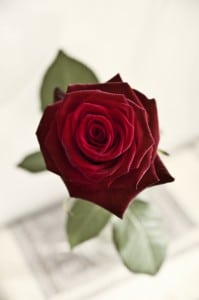 As it’s Valentine’s Day today, I just wanted to share with you some facts about courtship in Tudor times. David Cressy, in his excellent book Birth, Marriage, and Death: Ritual, Religion, and the Life Cycle in Tudor and Stuart England, writes of how “courtship was no mere game or idle dalliance” and that its goal was marriage. It was a serious business and although there was no set “ecclesiastical ritual”, there were “unwritten rules” and steps that were followed by society:
As it’s Valentine’s Day today, I just wanted to share with you some facts about courtship in Tudor times. David Cressy, in his excellent book Birth, Marriage, and Death: Ritual, Religion, and the Life Cycle in Tudor and Stuart England, writes of how “courtship was no mere game or idle dalliance” and that its goal was marriage. It was a serious business and although there was no set “ecclesiastical ritual”, there were “unwritten rules” and steps that were followed by society:
- Matchmaking – A couple were often brought together by the ‘matchmaking’ of parents or well-intentioned friends. Proverbs like “Like blood, like good, and like age make the happiest marriage” were taken into account as it was important that a couple was well-matched.
- The man would woo the woman by visiting her regularly and giving her gifts such as ribbons, girdles, gloves and coins. His aim was to win her over so that the courtship could progress to the next step.
- Once the couple had agreed to marry, there was the betrothal(also known as espousal or handfasting). This could simply be a private agreement between the man or woman, or it could be a proper public ceremony where hands were joined, pledges were made and a ring sometimes given. At this point, the couple saw themselves as ‘married in the eyes of God’ and so may have started sexual relations. This is one reason why some 20-30% of babies were born within 8 months of marriage, they were conceived between betrothal and marriage.
- Marriage – A public church ceremony consisting of the priest reading the banns, asking the people if there were any impediments to the marriage, the woman being given away by her father or adult male friend, the joining of hands, the making of vows, the blessing of the ring, the giving of the ring, and then the nuptial mass and blessing. Interestingly, the ring was not put straight on the ring finger, it was moved from thumb to each finger in turn as the words “In the name of the Father «thumb», and of the son «first finger», and of the Holy Spirit «middle finger», Amen «ring finger».” The ring finger was said to have a vein running from it straight to the heart. During the ceremony, the woman would stand on the man’s left side, symbolising the fact that Eve was made from one of Adam’s left ribs.
Cressy points out that in the upper classes a successful courtship often rested on financial matters, such as the woman’s dowry, portions (a share of inheritable estate given in marriage) and the woman’s jointure (the estate reserved for the wife in event of the husband dying). All this had to be negotiated between the two families during courtship and couples could be broken apart if financial negotiations went pear-shaped or if it was found that one of the couples was actually pre-contracted to someone else. Cressy also makes the point that couples were not forced into marriage and that marriages were only valid if the man and woman had both agreed to marry. Fathers and other adults could of course advise and act as matchmakers, to get the best possible match, but they were not supposed to compel the young person to marry someone they did not like.
We often think of such arranged marriages as ‘loveless’, but courtship was all about the man wooing the woman and the couple getting to know each other and to like each other enough to commit to marriage. Cressy explains that popular lore was “to marry first, and love after by leisure” but the couple were only supposed to become betrothed, and then married, if they liked each other. ‘Like’ was then supposed to lead to ‘love’ and a happy and successful marriage. Of course, sometimes things happened the other way round, with a couple falling in love and then having to go through a formal courtship and negotiations before they could marry. One famous “love match” was that of Robert Dudley and Amy Robsart, of which William Cecil, a guest at their wedding, said “nuptii carnales a laetitia incipiunt et in luctu terminantur’” or “carnal marriages begin in joy and end in weeping”. Unfortunately, his words were quite prophetic and the marriage ended with Amy falling to her death down a staircase in 1560.
I don’t want to end on that note on this day of love and romance, so please comment below with examples of love matches or Tudor marriages which proved to be happy and loving…
Notes and Sources
- Birth, Marriage, and Death: Ritual, Religion, and the Life Cycle in Tudor and Stuart England, David Cressy
- ‘Dudley , Amy, Lady Dudley (1532–1560)’, Simon Adams, Oxford Dictionary of National Biography, Oxford University Press, 2004